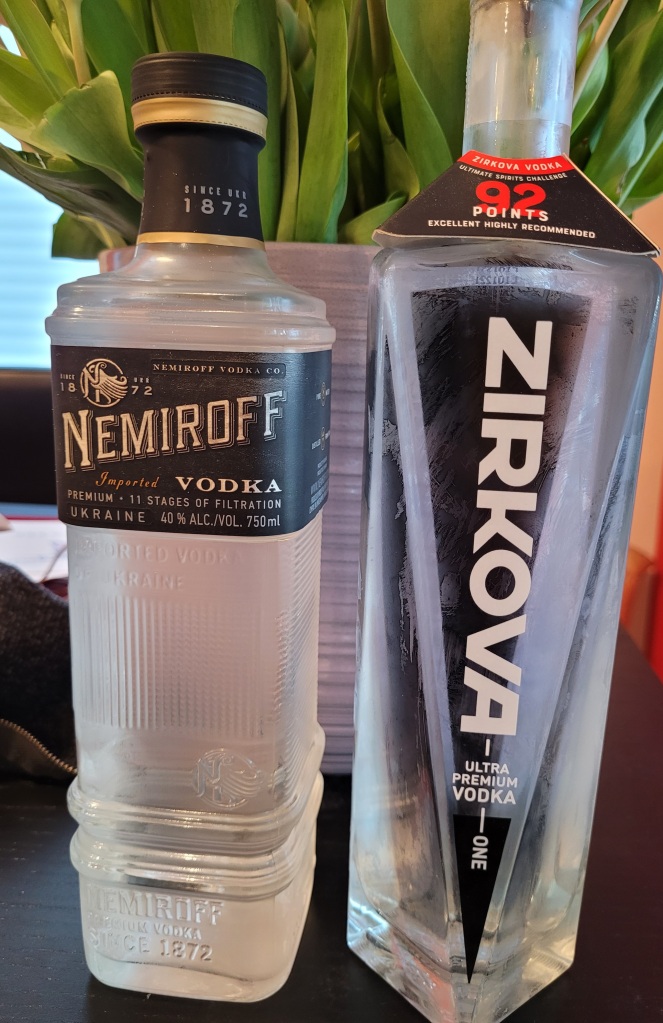When the Russian invasion started, people here in Canada flocked to buy Ukrainian vodka as a sign of support (and because, well, it’s good). Liquor stores also pulled Russian vodka from their shelves. I’m not sure if Ukrainian vodka is still being produced and exported here – active warzone and all – but it’s still available on shelves.
There is an interesting semantic difference between “vodka” and the Ukrainian word “horilka” – they’re often used interchangeably. Some sources say that vodka was originally made from mixed grains, while horilka is made from just wheat, but since most are all made from various grains / potatoes these days, that difference isn’t really relevant anymore. Realistically, horilka is the Ukrainian name for 40%-ish clear spirits. Most bottles exported to Canada are labelled vodka, since that’s the term people are familiar with.
These are the two main brands of Ukrainian vodka available in Ontario – Nemiroff and Zirkova. Nemiroff has a historical connection going back to 1872, originally founded by a Count during the Russian Empire, then nationalized by the Soviets, and restarting as a private company in 1992. It’s unclear if it’s really a continuation of the company or a new company using the old one’s branding and distillery, but that feels like I’m putting too fine a point on it.
Zirkova has it’s own interesting history – the company was founded in Canada by Katherine Vellinga, the daughter of Ukrainian immigrants, but the vodka is entirely distilled and packaged in Ukraine, then the whole production run is shipped for sale in Canada. When the war started, she began to donate 100% of profits to humanitarian aid, turned the distillery over to medical sanitizer production, and worked to use it as a hub to help employees and their families to safety. It’s understandably unlikely that any more bottles will come to Canada, but there’s still over 7000 bottles in stock at the LCBO across Ontario right now.
As for flavour comparision – vodka tends to be hard really tell apart, especially with good quality brands since the better a vodka is, the purer and less flavoured it is. Side by side, I would say Zirkova is more neutral, while Nemioff is a bit sharper and grassier.
A really distinctively Ukrainian angle is the love of infusing flavours into vodka – chili peppers or horseradish are common, as well as berries or spices. There’s also a hot spiced version that’s kind of like a mulled wine. I’m going to make a few from the vodka, the recipes tend to be simple: put the flavouring in, let it sit for a few days or weeks, shake occasionally, strain, drink.
I’m trying spotykach (“stumbling”) with a recipe from Authentic Ukraine – vodka infused with spices like cinnamon, cloves, saffron (what I call “Christmas spices”), then boiled with some sugar and served cold. The straight vodka itself tasted wonderful after steeping for a week – cinnamon, cloves, and nutmeg come out strongest, though the saffron isn’t too present. Boiling in some sugar makes it wickedly easy to drink, hence the name, and feels like it could be used in a lot of mixed drinks – instead of rum in a rum punch, or mixed with black tea would work great.
I’m also making a flavoured lemon horilka with a recipe from Ukrainian Diaspora. It’s very simple – take off some lemon peel with a vegetable peeler (the peeling is important so you don’t get bitter pith) and let it steep in vodka for a few days. It is also absolutely delicious – it’s got a strong, fresh lemon flavour that is beautiful. This is a total winner – it’s good on its own right out of the freezer, but mixing it with a bit of sparkling water knocks it out of the park for a summer drink. This also keeps in the freezer for a long time.
























